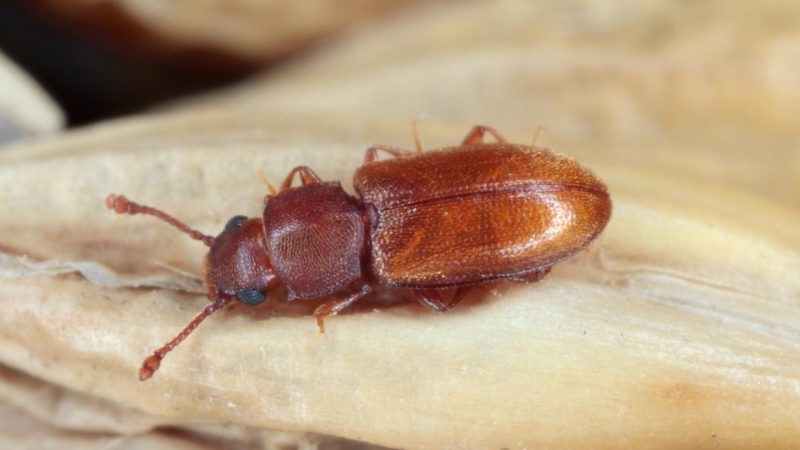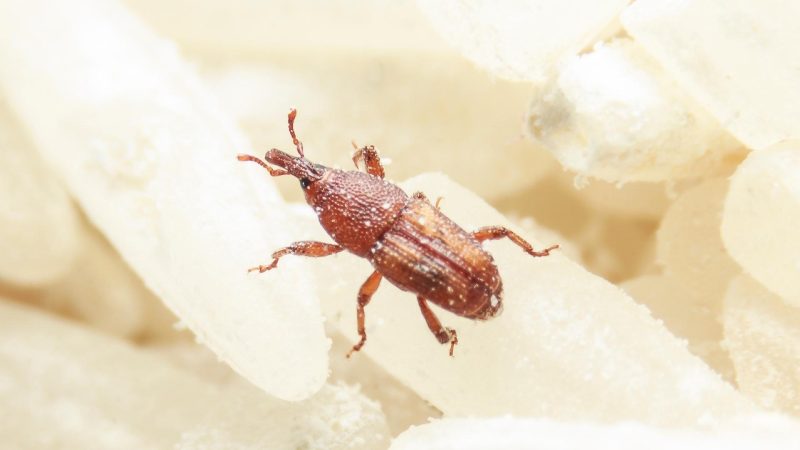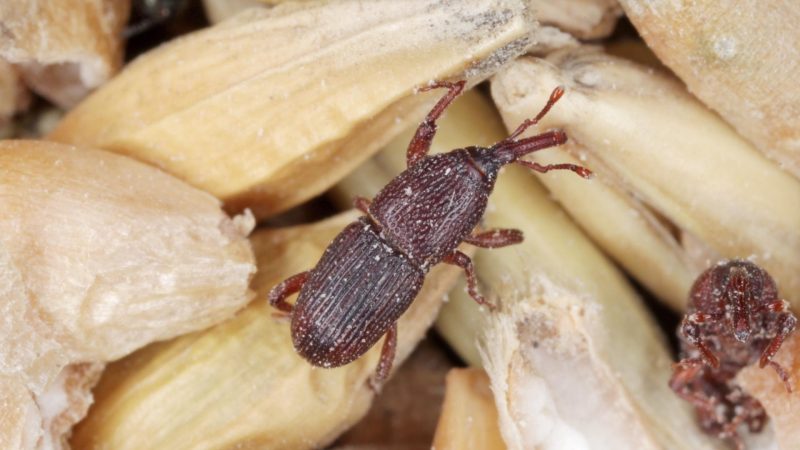Having some tiny brown bugs in your house can be intimidating, especially if you don’t know what they are. While inside, they can be in your kitchen because most of them are attracted to moisture and food. Without your knowledge, they are already causing severe damage to your stored food.
So, what could be the tiny brown bugs in your kitchen? The small brown bugs in your kitchen could be foreign grain beetles, rice weevils, granary weevils, warehouse beetles, or Khapra beetles. All of them eat stored grains and seeds, and one of them is considered one of the world’s most invasive pests.
Unfortunately, these tiny brown bugs in your kitchen and bathroom are not easy to differentiate from each other.
Aside from their very small sizes, these household pests are very good at hiding inside the food. In this comprehensive guide, you will learn how to identify these tiny bugs and how to get rid of them.
Top 5 Tiny Brown Bugs in Kitchen
1. Foreign Grain Beetles

Scientifically known as Ahasverus advena, foreign grain beetles belong to the family Silvanidae and are closely related to sawtoothed grain beetles.
Also called new house bugs, they are commonly found in newly constructed houses, and are abundant during late summer and fall (or between August and September).
Foreign grain beetles prefer living in damp areas where fungi grow. They are very attracted to moisture and may infest your bathroom and kitchen.
No wonder they will start to appear in bathtubs and sinks. Although they love new houses a lot, they can also be nuisances in old houses with molds and excess moisture.
What Do Foreign Grain Beetles Look Like?
Foreign grain beetles are usually brown or reddish-brown, about 1/12 inches long, with flat bodies, clubbed antennae, and small round bumps or knobs on the front corners of their thorax. But because they are almost invisible to the naked eye, they look like gnats and bed bugs, except that their bodies have hard shells.
Also nicknamed plaster house bugs, foreign grain beetles are very strong flyers, and they fold their wings at rest or when they land.
At some point, people have mistaken them for fruit flies, which are also great flyers. This is why it’s better to use a magnifying glass when trying to identify tiny bugs in your kitchen.
What Do Foreign Grain Beetles Eat?
Foreign grain beetles feed on a wide variety of moldy stored food products such as grains, cereals, oilseeds, herbs, and spices.
These tiny brown bugs rarely eat dried fruit unless they are old, moldy, or in very poor condition. They also eat dead insects, fungi, and pure mold. Larvae grow in their food sources.
Are Foreign Grain Beetles Harmful to Humans?
Foreign grain beetles are not harmful to humans and pets. They don’t bite or sting people, and they don’t carry infectious diseases.
These tiny brown bugs also don’t damage plants, furniture, clothing, and personal belongings. But despite not being considered dangerous, they can still damage food and food products.
How to Get Rid of Foreign Grain Beetles in Your Home?
As mentioned above, foreign grain beetles are pantry pests but are only temporary nuisances. This is because they are very likely to leave on their own once the dry season starts. Therefore, you don’t need pesticides in eliminating them. Instead, here are some natural ways to get rid of foreign grain beetles.
- Physically remove foreign grain beetles using a vacuum cleaner.
- Remove or clean old or spilled grains and cereals, where they could be present.
- Reduce all their potential entry points. Seal all cracks and crevices around your walls, doors, and windows. You should also fix leaky pipes.
- Increase ventilation in grain storage areas, kitchens, and bathrooms by placing fans or air conditioning units during summer and fall months.
- Foreign grain beetles usually leave areas with a humidity level of below 60%. To maintain low humidity, use a reliable dehumidifier such as Gocheer Upgraded Dehumidifier .
2. Rice Weevil

Scientifically known as Sitophilus oryzae, rice weevils are common pests of stored grains in storage facilities or processing plants around the world.
They belong to the family Curculionidae, which includes granary weevils. Although they are rarely indoors, they may infest homes with stored grains and cereals.
What Do Rice Weevils Look Like?
Adult rice weevils are dull reddish-brown to brown and are about 1/8 inches (3.175 mm) long. They have slender, hard-shelled bodies with four faint red to yellow spots on their wing covers (elytra) and a snout of about 1 mm long.
Their prothorax (the area behind the head) is as long as the head and snout combined.
On the other hand, rice weevil larvae are legless, humpbacked, and white to creamy white. These worm-like immature weevils also have a brownish-black to tan head.
They stay inside the seeds or grain kernel for about 18 days before entering the pupal stage, which lasts for about 6 days until they become adults.
What Do Rice Weevils Eat?
Rice weevils feed on rice, dried beans, corn, cashew nuts, oats, popcorn, wheat, and cereal products. These small brown bugs also eat apples, grapes, and pears. While growing in the seeds, larvae eat and hollow them. The new adults will remain in the seed for 3-4 days until they are already fully matured.
Are Rice Weevils Harmful to Humans?
Rice weevils are not harmful to humans because they don’t bite or sting. They also don’t carry or transmit infectious diseases and don’t feed on wood, fabric, and any kind of structure. Instead, they only infest stored grains, cereals, and seeds. Therefore, rice weevils are notorious pests and cause heavy infestations.
3. Granary Weevils

Scientifically known as Sitophilus granarius, granary weevils are also common pests of grains, just like rice weevils. However, they are more common in cooler climates than in warmer regions. However, granary weevils can also infest homes, especially those with stored seeds, cereals, and grains.
What Do Rice Weevils Look Like?
Also called wheat weevils, granary weevils are reddish-brown to brown. They also have long, slender snouts, sharp jaws, and elongated oval pits on their thorax. But unlike rice weevils, their color is uniform, and they have no spots on their bodies. Also, granary weevils are wingless, and therefore, they cannot fly.
Adult granary weevils are a bit bigger than adult rice weevils and are 1/8-1/4 inches long. Amazingly, they can play dead when disturbed. However, you may need a magnifying glass to notice their difference. Meanwhile, granary weevil larvae look exactly like rice weevil larvae and they have the same habitat.
What Do Granary Weevils Eat?
Granary weevils feed on the same wide variety of grains, seeds, and grain products that rice weevils eat, and both species have the same eating habits. Adults also chew very small holes on grains and lay eggs inside. When eggs are hatched, larvae eat the interior of the grains and seeds until they become adults.
Are Granary Weevils Harmful to Humans?
Just like rice weevils, granary weevils are also not harmful to people and pets. They don’t sting or bite humans, and they don’t carry diseases. In fact, accidental eating of any stage of weevils cannot make you sick. Similarly, these small brown bugs don’t damage wood or structures, but they are still considered grain pests.
How to Get Rid of Rice Weevils and Granary Weevils in Your Home?
Rice weevil and granary weevil infestations are quite hard to notice unless severe. This is because larvae hide in grains, and you will only see the adults emerging from inside. Therefore, a thorough inspection of stored food products is necessary. Below are some ways to get rid of these two weevils in your house.
- If you are having difficulties in locating weevils, place sticky traps such as Black Flag Pantry Pest Trap in your kitchen and food storage areas. This product is non-toxic and very easy to use.
- For severely infested food products, dispose of them immediately.
- For small quantities of grains that are lightly infested, try saving them by heating them at 140°F (60°C) for about 15 minutes.
- Alternatively, you can freeze them. All stages of weevils will die if exposed at 0°F (-17.78°C) for 3 consecutive days.
- To help prevent weevils from entering your house, inspect grain packages before buying them. Buy only what you need in a short time.
- Keep grains in sealed containers such as plastic, glass, or metal. Avoid using cardboard boxes or plastic bags since weevils can easily chew through them.
Related: How To Get Rid of Rice Weevils: A Complete Guide
4. Warehouse Beetles
Scientifically known as Trogoderma variabile, warehouse beetles are household pests that are closely related to Khapra beetles and carpet beetles.
However, they are fairly short-lived as compared to them. They are pests of stored food products but are not as common as the other beetles in the Dermestidae family.
What Do Warehouse Beetles Look Like?
Adult warehouse beetles are usually brownish-black, about 1/8 to 3/16 inches long (3.2 to 4.7 mm) with oblong to oval bodies and a brown and yellowish mottled pattern on their wing covers. These very tiny bugs are considered excellent flyers and can disperse very fast once you try to disturb them.
On the other hand, warehouse beetle larvae are yellow-white to dark brown and can grow up to 1/4 inches long (6.35 mm).
They have a tapered, cigar-shaped body with long clumps of hair (hastisetae) on the last three segments of their abdomen. These hairs serve as their defense tools against predators.
What Do Warehouse Beetles Eat?
Warehouse beetles feed on a very wide variety of foods. This includes barley, beans, candies, cereals, cocoa, cookies, corn, fish meal, flour, nuts, oatmeal, pet foods, potato chips, powdered milk, spaghetti, spices, and dead insects such as boxelder bugs and ladybugs. They don’t eat whole grains, though.
Are Warehouse Beetles Harmful to Humans?
Warehouse beetles are harmless to humans and pets and are not known to bite or sting. They also don’t carry diseases or damage properties and other personal belongings. However, accidental eating of warehouse beetle larvae and their shed skin (especially their hair) can cause gastrointestinal problems.
5. Khapra Beetles
Scientifically known as Trogoderma granarium, the Khapra beetle is considered one of the 100 worst invasive species of stored grains and seeds worldwide. In fact, a massive infestation in California was discovered in 1953 and lasted until 1966. The US government has spent around $15 million in eradicating them.
Also called cabinet beetles, Khapra beetles have been declared important regulated quarantine pests around the world. This is because these voracious pests can survive for a long time even under extreme conditions and require only a little moisture. This beetle is currently not present in Australia.
What Do Khapra Beetles Look Like?
Khapra beetles are 1.6-3.0 mm long and 0.9-1.7 mm wide. They have brown to black bodies, a small deflexed head, reddish-brown markings on their elytra, and yellowish-brown legs. Their antennae are yellowish-brown, with a club of 3-5 segments and 9, 10. or 11 short segments. They have wings, but they don’t fly.
Once the eggs are hatched, Khapra beetle larvae are 1.6 to 1.8 mm long, with a brown head and a yellowish-white body. As they continue to grow, their color slowly changes to gold or reddish-brown. Mature larvae reach up to 6 mm long and 1.5 mm wide. At this point, their body is already covered with lots of hair.
What Do Khapra Beetles Eat?
Khapra beetles eat everything that warehouse beetles eat. However, mature larvae feed on whole grains, and younger larvae also eat damaged seeds, while warehouse beetles don’t eat whole grains. Nonetheless, a single adult Khapra beetle eats only a little part of the grain but can damage very huge amounts of food.
Are Khapra Beetles Harmful to Humans?
Khapra beetles are not harmful to humans since they don’t bite or sting. Despite being very notorious pests, they don’t carry diseases or damage properties. But just like warehouse beetle larvae, their larvae have body hairs that can cause intestinal problems once you have accidentally eaten them.
How to Get Rid of Warehouse Beetles and Khapra Beetles in Your Home?
Infestations due to warehouse beetles or Khapra beetles are very hard to control. First of all, they look very similar, and you may need a professional to help you identify which is which. Their larvae also multiply very quickly, and they are very good at hiding. But anyway, here are some ways to get rid of them in your home:
- For minor infestations, chemical-free sticky traps such as KGK Sticky Traps can help you know where these tiny bugs are coming from.
- Carefully check all highly-suspected foods and throw away those that are heavily infested. Note that larvae are most active just before dusk.
- Thoroughly vacuum empty storage cabinets, shelves, and other areas where there is spilled or infested food material.
- Both species are very cold tolerant and will still survive when exposed to 68°F (20°C). However, all life stages will die if exposed to 140°F (60°C) for 30 minutes.
- Buy packaged food only from reputable stores and dealers, and avoid buying pre-opened food product packages.
Summary
Insecticides are not recommended for use indoors, especially on food products. Most of them are also not effective in killing very small bugs within packages. In extremely severe infestations, you may need a professional pest control operator to fumigate your house. Proper sanitization is still the best preventive method.
List of Sources
Hahn, J., Kells, S. (2020). Foreign grain beetle. University of Minnesota Extension.
Koehler, P. G. (2018). Rice Weevil, Sitophilus Oryzae (Coleoptera: Curculionidae). University of Florida.
Mason, L. J. (2018). Warehouse Beetle Trogoderma Variabile Ballion. Purdue University Extension – Entomology.
Khapra beetle – declared pest. (2020). Government of Western Australia – Agriculture and Food.
- How to Get Rid of Turtles | Proven Long-Term Solutions! - August 26, 2023
- How to Get Rid of Kingsnakes | Easy & Humane! - August 26, 2023
- How to Get Rid of Northern Water Snakes | Best Solutions and Preventative Measures! - August 19, 2023
